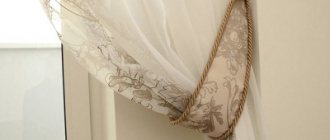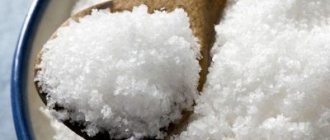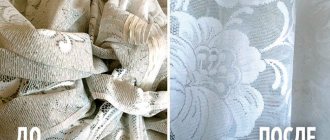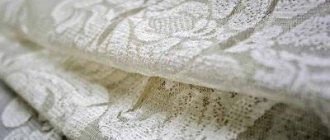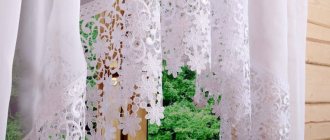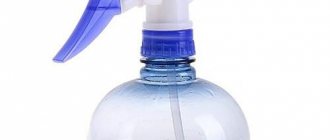Why did the tulle turn yellow or gray?
When you see that the curtains have lost their festive snow-white hue, you should not be upset. It is possible to return whiteness within 3–4 months. To decide how to bleach tulle, determine the type of material and establish the reason for the color change. Unpleasant color is caused by various factors:
- tobacco smoke;
- direct rays of the sun;
- ironing with a hot iron;
- proximity of heating devices;
- wash together with colored items;
- exhaust gases entering the apartment from the street;
- processing in hard or hot water;
- uneven rinsing, in which dust particles and grains of powder remain between the fibers.
Having established the cause of the contamination, it is easier to make the curtain white.
Kitchen curtains become dirty with soot and grease. Having determined the source of contamination, they decide how and with what to bleach the tulle from gray and yellowness.
Reference! Sometimes curtains made of organza, silk or muslin should be taken to the dry cleaner: at home it is difficult to remove dirty deposits from thin material. It is useless to try to remove old stains even with strong drugs. There is a risk of damaging textiles.
Secrets of whitening nylon tulle
You can often see that synthetic fabric is mixed with natural fabric (cotton) and it is perfectly bleached by hydrogen peroxide, which is a component in many detergents and bleaches, such as Vanish.
Therefore, nylon, being a synthetic fabric, will acquire a boiling whiteness in solutions using hydrogen peroxide.
Whitening tulle with hydrogen peroxide
So, in warm water, dilute 1 tablespoon of peroxide per half liter of liquid. Soak for two or three hours. And rinse well in several waters.
Selecting a method
Young housewives sometimes do not know how to properly wash a tulle curtain. To wash away dirty deposits and remove stains, curtains are washed in a basin or in a machine with available products or substances for caring for fine fibers. Hand washing takes a lot of time. Automatic processing saves the housewife’s energy and time. In order not to spoil the material, return the white tint; the method, temperature and operating mode are chosen in accordance with the type of fiber.
Delicate fabrics require careful care
How not to ruin tulle
So that in pursuit of the idea called “how to make tulle snow-white”, you do not suffer disappointment due to spoiled favorite curtains, you need to remember some rules.
- During the soaking and washing process, tulle comes into contact with various agents that can be aggressive to some types of fabric. Therefore, before deciding how to bleach the tulle, you need to study the information about the composition and the manufacturer’s recommendations on the label.
- Curtains made from artificial fibers should not be exposed to high temperatures, and only fabrics made from natural fibers (cotton and linen) can be boiled.
- If you use purchased detergents for washing, you should strictly follow the instructions written on the packaging.
- If the curtain is bleached using powdered folk remedies, then after dilution it is better to strain the resulting mixtures so that no stains remain on the fabric.
- When using any substances for bleaching, you must strictly observe their dosage and time of exposure to the material.
- Curtains are washed in machines on delicate cycles, and during hand washing they are not twisted and hung damp.
If you follow these simple rules, the tulle will never deteriorate.
Handwash
If you know exactly how to wash a white tulle curtain by hand, even delicate organza, silk, and veil will not be damaged and will be cleaned. This is a gentle processing method in which the owner controls the process, regulates the force of influence on the canvas, preventing damage. Before washing tulle, select a washing liquid or powder and perform the following steps:
Preparing tulle
The product is removed from the cornice. Carefully shake out any dust accumulated between the threads. They try to deal with old stains before work: wash the stained area with a detergent, and wash it off after 3–40 minutes.
Additional Information! When washing by hand, avoid rough friction and the use of sponges and brushes. 10 - 15 minutes after soaking, the material is carefully squeezed and unclenched with your hands, and gently tapped.
Even dirty curtains need to be removed carefully and carefully.
Pre-soak
Pour lukewarm water into a large container and add gel or powder. Prepared items are placed in liquid. After 2–4 hours, if the textile is heavily soiled, replace the liquid with a new one. After soaking, the item is bleached. The treated curtains are rinsed twice to wash away any remaining powder and eliminate the odor. Dry flat, without squeezing: twisting causes holes and creases to appear. When the water has drained, the wet curtains are shaken and returned to the curtain rod.
Good to know, read: - The best and most effective ways to wash windows without streaks at home.
Additional recommendations
- Be sure to wash your tulle before bleaching. Many housewives make the mistake of bleaching dirty fabric. As a result, dust penetrates deeper into the fabric and aggravates the situation;
- Remove greasy stains from fabric before bleaching. Dilute 50 ml of vinegar in 1 liter of water, add 3-5 drops of dishwashing detergent, soak, wash the tulle and start bleaching;
- control the temperature. For delicate fabrics it is +30…+35 ℃. When washing tulle in a washing machine, set the speed to no more than 400 rpm.
- To make the curtains shimmer in the sun, add 1 tbsp when washing. l. vinegar. This amount will not leave an unpleasant odor, but will add shine;
- do not squeeze the tulle, especially using twisting. Just let the water drain;
- no need to iron the tulle. When drying, the fabric will smooth out under its own weight.
Airy white tulle gives the space a special lightness and chic
Please note that different bleaching methods are suitable for each type of fabric.
| Type of fabric | Whitening methods |
| Veil | Ammonia, starch, salt |
| Organza | Zelenka, salt, starch, ammonia |
| Capron | Zelenka, potassium permanganate, soda, starch, salt, citric acid |
| Jacquard | Laundry soap, soda |
| Chiffon | Laundry soap, salt |
| Cotton, linen | Boiling, bluing and all other methods |
Green paint helps against yellowness, blue paint helps against grayness, and ammonia, vinegar and hydrogen peroxide get rid of greasy stains on tulle.
Using these methods, you can return the fabric to its freshness and sparkling whiteness. What methods of bleaching tulle do you use? Share your experience with us in the comments.
Automatic wash
Wet cleaning in a machine will not spoil the structure of delicate fabrics if you set the mode correctly and choose detergents. Before you decide to wash a tulle curtain so that it is snow-white and clean, you should get acquainted with the algorithm of actions.
Preparing for whitening
The curtain removed from the cornice is freed from the hooks and cleaned of dust. Before automatic processing, the product is pre-soaked. To clean and bleach a tulle curtain at home, use a substance appropriate to the type of material. Delicate fabrics tolerate non-concentrated solutions of salt and soda.
Gels are rinsed out of delicate threads without leaving any traces
Choice of product
To wash tulle curtains at home until they are white, use oxygen-containing bleaches or products for cleaning white fabrics. The volume is calculated according to the instructions. It is prohibited to use preparations containing chlorine, since the element is potent:
- destroys delicate threads;
- provokes the appearance of a yellow-gray plaque;
- causes metal corrosion and destruction of rubber outlet pipes of the machine.
It’s useful to know, read: - How and with what to remove double-sided tape in 5 minutes from different surfaces.
Before washing the tulle, it is worth softening the water, otherwise scale microparticles will get stuck between the threads and give the curtains a gray tint. To do this, powders with a softening effect (Ariel, Persil), tablets or Calgon gel are added to the detergent. Folk remedies soften liquid and whiten textiles:
- lemon acid;
- soda;
- shavings of light laundry soap.
When cleaning dense material, add soda ash.
You can soften water using folk remedies
Washing bag
The curtains are straightened, carefully folded into a rectangle and placed in a calico pillowcase or a special bag made of heat-resistant mesh. The outer shell allows water and air to pass through, retains the shape of the curtain, and protects the thin fabric from the accidental appearance of puffs and pellets. The packaged product is placed in the drum of the machine.
Reference! Even when using a bag, curtains should not be washed together with clothes and other things.
Which mode to use
Thin tulle curtains can be washed in a gentle cycle, after turning off the spin cycle. Thick linen and cotton textiles are also cleaned in a delicate mode, but spinning is allowed at low speeds. Depending on the material, it is determined at what temperature tulle curtains should be washed. Airy organza, veil or jacquard are processed by setting the low temperature mode (+30 - 35℃). When caring for flax and cotton, the temperature is increased.
Delicate mode is best for tulle.
Useful tips
There are several recommendations that it is advisable to find out before the procedure. Following them will help you achieve good results.
- It is advisable to shake off the dust from the tulle. It's better to do this outside. If you put the curtain to be washed directly, a large amount of dust will be absorbed into the structure of the fabric.
- Before bleaching, it is correct to wash the accessory by hand or in a machine (depending on the material). Bleaching cannot replace washing, and if it is neglected, the result will not be very good.
- Washing should be done on a delicate cycle without spinning. Otherwise, wrinkled tulle will be difficult to iron out. The drying sequence should be as follows: hang the washed curtains so that the liquid drains from them, and when the dripping stops, you can return them to the curtain rod, where they constantly hang. All folds will straighten out under their own weight.
- By the way, in order for the material to wrinkle less, it must be carefully folded before loading it into the drum. This will help avoid unpleasant creases that form due to careless handling.
- Water for treatment should have a temperature of no more than 30 degrees. If you soak it in hot water, the yellowness will penetrate even deeper into the thread.
Features of bleaching depending on the material
To decide how to make a tulle curtain snow-white, check what material the product is made from, choose a cleaning method and bleach.
Capron
Before you start bleaching the nylon tulle, the curtain is kept in a saline solution for 45 minutes. To care for nylon, use chlorine-free preparations and home remedies:
- starch;
- brilliant green;
- blue;
- laundry soap.
Nylon is bleached in cool (+30 – 35℃) water manually or by machine, setting the delicate mode.
Additional Information! Soot and traces of grease are removed with dishwashing gel. Before wet treatment, the dirty area is lightly moistened with liquid, after 30 minutes it is washed off, and the item is washed.
Organza
Light fabric made from twisted polyester or silk fibers should not be roughly rubbed or pulled. Chemicals should not be used for whitening. Yellowness can be removed using the following means:
- light laundry soap;
- hydrogen peroxide;
- salt;
- blue;
- brilliant green.
Hand washing in cool (not higher than +35℃) water is acceptable. If you clean it in a machine, turn on the gentle program.
Special delicate approach to delicate fabrics
Batiste
Translucent fabric is woven from cotton or linen fibers. Thin textiles are resistant to high temperatures. To clean and lighten, it is permissible to boil with soap or pre-soak with starch solution or ammonia. Rinse by adding hydrogen peroxide.
Good to know, read: - 20 ways to remove traces of adhesive tape from plastic and other surfaces.
Veil
An airy veil made from cotton or silk threads must be taken care of carefully: the fibers are easily damaged. Hot water and substances containing chlorine are not used. Machine cleaning is acceptable if it is possible to set the speed to less than 400 rpm, a gentle program. Before loading into the drum, the item is carefully rolled up and placed in a mesh bag or pillowcase. You cannot wring out the veil.
With delicate products, the fabric looks like new for a long time
Kiseya
The fabric is made up of cotton, synthetic or silk threads woven together, into which beads, bugles or seed beads are woven. Needs careful but infrequent cleaning. The muslin is first soaked in starch liquid or hydrogen peroxide solution, then rinsed and washed with powder. Bleaching with ammonia after removing dirt in a powder solution.
Tulle mesh
The lightweight mesh fabric is created by weaving polyester threads and is therefore moderately durable. To keep it clean and snow-white, the curtain is dipped in a saline solution mixed with gel or washing powder. After 40 minutes, rinse.
Reference! Tulle can sometimes be treated with bleach. But if potent drugs are abused, the material will quickly lose its shine and strength.
Jacquard
The textile is woven from polyester, the weave of the fibers resembles lace. Jacquard fabrics look elegant and require careful handling. Therefore, soap, soda or mild chlorine-free products are used for bleaching. Machine wash only at low speed in cool water.
Many delicate fabrics are washed by hand
Chiffon curtains
Chiffon is a delicate material created from a mixture of cotton, synthetic and silk threads. On the surface of the canvas, puffs and pellets easily appear from a careless touch. The product is immersed in a cool soap-salt liquid until the components are completely dissolved. The washed item is not wrung out.
Tulle mesh
Dust and dirt particles accumulate in the cells. You should not pickyly choose how to bleach mesh tulle from gray: the mesh easily tolerates any bleaching compounds and processing methods. But twisting and squeezing are excluded in care: the structure of the delicate matter is quickly damaged.
It’s useful to know, read: - Simple ways to wash brilliant green in 5 minutes.
Linen tulle
Natural material is durable. Linen turns yellow in bright sun, but wears out from frequent cleaning. Before bleaching a yellowed linen tulle curtain, the item is dipped in a hot (45 - 50 ℃) washing solution. After 1.5 hours, rinse thoroughly, put in diluted ammonia or “Whiteness,” which refreshes the color of durable fiber if used rarely (once every 3 to 4 months).
How to properly wash tulle from different materials
Each type of material requires an individual approach, and thin, delicate materials require special attention and treatment, and only in this case will they continue to decorate the house and delight for a long time.
How to bleach nylon tulle
Nylon is a very durable material. Curtains made from it serve for a long time, do not lose their shape, but over time they lose their original color, fading, turning yellow and gray. But you can bleach nylon curtains with various means, both homemade and purchased.
Curtains made of nylon threads bleach perfectly:
- salt (in a solution of 3 level tablespoons and 10 liters of water you need to keep the curtains for about four hours),
- starch (after washing, the curtains are placed for half an hour in a mixture of a glass of starch and a bucket of water),
- refreshed with blue (kept in water, blued with one cap of the product for an hour) and green (the same as in the case of blue, kept for some time in 10 liters of water in which brilliant green was dissolved in a dosage of no more than 10 drops per 250 milliliters liquids).
Oxygen-containing bleaches are suitable from commercial products.
Acetone and alkaline substances should not be used to remove stains, as they can dissolve nylon threads.
It is also not recommended to use chlorine-containing bleaches and acids; they have an aggressive effect on nylon.
The maximum ironing temperature for nylon fabrics is 110 degrees, but washing is carried out at a temperature no higher than 40.
How to wash organza tulle
Although organza is a delicate fabric made from viscose or silk, some bleaching agents can be used on it. Organza curtains are soaked before washing in water with a few drops of ammonia, in a solution of water with starch or in salt water (salt concentration 40 grams per 5 liters of liquid). After this, the curtains are washed with regular powder or a special product for tulle, for example, Splash or Cashmere.
Washing tulle from a voile
A light and airy veil requires a reverent attitude. Soaked and washed only in liquid detergents without pressing, twisting or putting pressure on the material. You can wash by hand or in a machine in delicate wash mode at 30 degrees without spinning. Before loading into the drum, it can be placed in a bag. You can bleach curtains made from this noble fabric in water to which 2 parts peroxide and 1 part ammonia are added. You can also use salt, bluing and laundry soap.
How to wash white chiffon tulle
It is better to wash white chiffon tulle by hand in warm water using liquid detergents. Curtains do not need to be squeezed, twisted or aggressively wrinkled. You can bleach with the same substances as the veil: peroxide, ammonia, salt.
Kiseya
Original decorative curtains made of threads must be washed very carefully to avoid tangling. First they need to be braided, then removed and placed in a bag. Place in a container of water to which liquid detergent has been added. Next, wash it carefully. Rinse the same way. Remove from the water, hang to drain, hang in place, unbraid and leave to dry.
Jacquard
Jacquard curtains with an intricate pattern, due to the special weave of the threads, can be made from different fibers, so the exposure temperature may vary. This point needs to be clarified on the label. Caring for such curtains depends on the composition of the fabric and is generally no different from other types of curtains, but there is one subtlety: it is important to take care of the design. It can become deformed from aggressive influence. Therefore, jacquard tulle does not need to be wrung out either during hand washing or during machine washing.
The use of chlorine bleaches is not recommended. It is better to use liquid detergents for washing.
Tulle mesh
The mesh is made from different fibers, so you need to know the exact composition. But the general rules for washing mesh curtains are as follows: they cannot be washed in a machine, they can only be washed by hand, despite the fact that they are quite strong and wear-resistant. Before washing, curtains should be soaked in a soapy solution, to which you can also add salt or soda. You can wash them in regular powder, but it is better to wash them in a liquid detergent or pre-dissolve the powder.
How to make tulle white using improvised means
Ordinary substances will help restore lost whiteness. Such products are hypoallergenic, effective, and affordable.
Salt
The use of these products requires soaking.
To cleanse dirt and bleach, tulle curtains are soaked in dissolved sodium chloride (for 5 liters - ¼ cup each of washing gel and salt). After 8-10 hours, rinse and wash using the usual method.
Additional Information! If you soak very dirty curtains twice (the first time in dissolved sodium chloride, the second time you add gel), you will be able to wash off even old grease.
Aspirin
The gray coating will disappear from the fabric after soaking in dissolved aspirin (take 5 tablets for 6 liters of lukewarm water). The textiles are cleaned of dust, placed in a basin, and filled with washing liquid. After 3 hours, wash.
Soda
An alkaline solution easily removes dirt and restores the original color of even old fabric. To prepare the detergent composition, stir 30 g of sodium bicarbonate and the same amount of powder into 10 liters. An hour after soaking, the curtains are washed in a machine or by hand. Curtains made of linen or cotton are treated with soda ash, veil, organza, chiffon - only food grade.
Reference! Remove the dirty gray coating and bleach the tulle with a mixture of salt and soda: take 7 tbsp for 10 liters. spoons of alkali, 9 tbsp. spoons of rock salt. The curtains, cleaned of dust, are kept in the prepared composition for 1.5 hours, then washed thoroughly. Wash with gel or soap.
Boric acid
Folk remedies will help remove grayness and yellowness.
The drug can bleach old nylon tulle, covered with a gray coating and yellow spots. It is easy to verify the effectiveness of the method; to do this, follow these steps:
- 30 ml of boric acid is diluted in five liters of warm liquid;
- curtains are soaked for 3 hours;
- rinse.
The product, which has regained its lost snow-whiteness, is straightened. Dry in a shaded place.
Useful to know, we recommend reading: What to do if a mercury thermometer breaks at home and mercury leaks out?
Vinegar
Table vinegar removes grayness and eliminates unpleasant odors embedded in the fibers. The curtains are dipped in a lukewarm salt-vinegar solution for 3 hours (the ingredients are taken in equal parts), then washed and dried.
Ammonia
Before bleaching tulle curtains with ammonia, the item is washed and then immersed in an unsaturated ammonia solution for 1.5 hours. After bleaching, rinse.
Additional Information! If dirt has become embedded in the thin fibers, ammonia is combined with 30 ml of hydrogen peroxide. In this way, soot and grease are quickly removed, and even old tulle that hangs in the kitchen is lightened.
Lemon acid
Dry matter or juice is added during the final rinse. Before this, the curtains are cleaned with white soap and lightened with peroxide. The washed curtains are kept in dissolved citric acid. After 15 minutes, carefully squeeze out without twisting.
Citric acid whitens and removes rust marks
Hydrogen peroxide
Hydrogen peroxide is a strong bleach that helps restore the whiteness of delicate tulle items. The curtain is placed in a capacious container, filled with diluted clarifier (4 tablespoons of the drug are used for 12 liters). After 4 hours, rinse.
Potassium permangantsovka
Restore the snow-white shade, remove stains and stains with a pale pink solution of potassium permanganate. The crystals are diluted in a transparent container and combined with shavings of light laundry soap. Stir and pour into a bowl of warm water. The curtains are soaked in foamy liquid for 3 - 4 hours.
Blue
Contaminated tulle can be cleaned in a washing machine or by hand. The washed curtain is placed in diluted blue for 25 - 30 minutes to remove the gray-yellow coating. The new soft blue shade will give the item an updated look.
Reference! When using dyes - blue, brilliant green - follow the dosage recommended by the manufacturer, monitor the saturation of the liquid, otherwise the curtains will acquire an undesirable color.
Zelenka
The yellowness will disappear from nylon and tulle after soaking in a saline solution with brilliant green. A bleaching agent is prepared from the following components:
- 0.5 liters of water;
- 4 table. spoons of salt;
- 20 drops of greenery.
The ingredients are thoroughly mixed, then diluted with water. The pre-washed curtain is immersed in a liquid greenish composition. After 15 minutes, the item is hung on a rope.
Laundry soap
Light laundry soap will return the yellowed product to its purity and snow-white tone. To do this, pour 0.1 kg of washing powder and 0.15 kg of soap shavings into a basin of heated water. The components are stirred until completely dissolved. The textiles are kept in the liquid mixture for 2 hours, turning occasionally. After treatment, wash. The final stage of cleaning is a gentle machine wash.
Additional Information! Curtains made from artificial fibers should not be cleaned with soap: the fabric irrevocably loses its shine.
Wash only with white soap
Starch
Starched curtains look elegant. Starch enhances the density of natural materials and repels dust particles. To make the fabric on the window gather into elegant folds, make a weak paste:
- First, the dry substance is dissolved and put on fire.
- Stirring constantly, bring to a boil.
- The boiling paste is poured into cold water.
- Breaks up lumps.
- The canvas is immersed in the prepared paste. They wait for the material to be thoroughly saturated with starch.
- Lightly squeeze and dry.
Wet curtains are carefully ironed.
Bleaching very dirty old tulle
If for some reason you do not want to get rid of a product that has lost its beauty, then you can try a set of measures to resuscitate cotton fabric at home, using the methods described above.
- First boil the curtain.
- Then use the method with ammonia and peroxide.
- Next step: soaking in saline solution.
- Finally, starch the fabric.
For synthetic materials, a more delicate technology is suitable.
- Use soaking with laundry soap.
- Next, it is better to resort to saline solution.
- Treat with brilliant green.
- And just like in the previous version - rinse with starch.
If these measures did not help, then it should be recognized that this curtain has already outlived its usefulness and you will have to either come to terms with its shortcomings or go for a new one.
Digestion
If washing the tulle did not help cope with yellowing, grandmothers and mothers boiled the curtains:
- they took a large enamel basin or bucket;
- water was poured into the container, soap shavings or powder were poured in;
- the product was placed into the liquid foam mixture;
- the container was placed on fire;
- after boiling, heated for an hour over medium heat, turning occasionally (the material was grabbed with metal tongs).
Curtains made from cotton fibers will become snow-white again after boiling.
Modern types of textiles add artificial fibers that require careful care. With prolonged boiling, delicate threads quickly melt and the fibers become deformed. Curtains made of organza, chiffon or nylon cannot be boiled. Curtains made from thick natural fabrics are sometimes boiled down, although the housewife has to control the process and should not leave the stove often.
Reference! If cotton textiles have turned yellow and dirty, the item is first boiled and then soaked in peroxide. If the dirty color remains, the fabric is kept in salted liquid, then rinsed and starched. Often this method should not be used: after 2–3 treatments, the fabric will become thinner and irrevocably lose its snow-white color.
General washing tips
Regardless of the product chosen for bleaching tulle, there are a number of rules that must be followed when washing, otherwise the product will quickly deteriorate and will have to be thrown away.
- Wash tulle at a temperature no higher than 30-40 degrees. Hot water, and especially boiling water, “seals” the gray plaque into the fabric.
- Always select the correct wash cycle. There are several modes that determine how to wash tulle in an automatic washing machine: direct “curtains” mode, delicate fabrics mode, sensitive wash, “delicates” mode, hand wash or “wool” program. The main thing here is to maintain a balance between intuitive choice and the modes of a particular machine.
- Before soaking in a solution with bleach, shake the product thoroughly to rid it of dust, or use a vacuum cleaner with a special attachment, setting the power to minimum.
- Lower the curtains into the container (drum of the washing machine) in a straightened form. It is recommended to fold the tulle into a rectangle. If you leave the curtains crumpled, then after washing there will be creases on them that will be impossible to iron.
- If you add a tablespoon of vinegar to the water, the tulle will shimmer with white light in the sun after washing. But this option is not suitable for washing tulle with synthetic fibers.
- Do not wash curtains with other items.
- When using a washing machine, do not set the spin speed to more than 400 rpm.
- Don't twist the tulle, just shake it.
- Do not iron curtains: high temperatures will permanently damage the fabric. We recommend hanging curtains on windows slightly damp. Then the folds will straighten out on their own under the weight of the product.
- Do not dry curtains near heating appliances.
We recommend: Laundry sheets - newfangled nonsense or a really good product?
Sometimes tulle is so dirty that you can no longer believe in the possibility of cleaning it from gray plaque. Try soaking the curtain overnight in a solution of water and washing powder first. And the next day, use bleach.
How to make fabric turn white using household chemicals
Most older generation bleaches contain chlorine. This element disinfects and brightens quickly, but aggressively - along with the yellowness, the structure of the fibers is destroyed. Such products should be used rarely, only for dense natural materials. To care for a veil, cambric, jacquard, choose chlorine-free compounds that act gently:
- Oxygen preparations containing sodium bicarbonate, hydrogen peroxide. When interacting with water, they release oxygen. Eliminate dirt, foreign odors and quickly exhibit whitening properties without disturbing the structure of the threads. The grayish-yellow coating returns after 2 - 3 weeks, but such compositions can be used regularly for washing curtains.
- Synthetic and natural materials are treated with optical brighteners. Powders remove dirt and lighten dark stains. Reflective microparticles do not eliminate, but hide the gray-yellow coating, so the curtains appear snow-white for 3-4 weeks.
Before washing the tulle, dissolve the detergent according to the instructions. Chemical mixtures act intensively even in cool water. Textiles are placed in the prepared bleaching medium. If using a machine, the clarifier and powder are poured into a special compartment. The washed item is rinsed and hung out to dry.
White
The clarifier is 95% chlorine. Causes allergic reactions. When working, wear gloves and open windows. The active ingredient removes yellowish circles, destroys dirty gray tint, and disinfects at +30℃. It is used for the care of linen and cotton curtains, for cleaning organza; muslin is not used, because the aggressive element thins the threads. Leave the curtains in the diluted mixture for 30 minutes before final cleaning.
Whiteness destroys delicate fabrics
Additional Information! After 1 – 2 soakings in “Whiteness”, the matter gets used to the active component and stops reacting to oxygen bleaches.
Wellery delicate white washing gel
Gently lightens cotton and synthetic fabrics. Contains optical brightening microparticles and enzymes. The hypoallergenic gel returns the snow-white appearance of curtains using any cleaning method, although it cannot cope with old dark stains, stubborn dirt and grayness. Dissolves in hot and cold water. Smells nice. Easily washed out.
Chirton oxygen bleach stain remover
Fragrant particles cleanse dirt and remove even old stains from berries, soot, and grease on curtains made of cotton and synthetic fabric. Chirton oxygen is considered one of the best effective drugs that restore the lost snow-whiteness of canvases. Enhances the effectiveness of gels. Intensively whitens at any temperature.
Other means
Similar preparations are used to bleach tulle curtains.
Bleaching preparations are selected for delicate threads
Frau Schmidt
Whitening tablets are designed for the care of delicate textiles. The packaging is designed for 5 wet treatments. Optical and oxygen-containing elements, enzymes destroy stubborn dirty stains even in hard and cool (+30℃) water. Does not cause allergies.
Cashmere
Small granules with optical brightening microparticles for the care of delicate natural and artificial fabrics. The yellowed fabric is soaked and cleaned in a warm solution. Removes nicotine film and yellowed greasy stains. Removes gray plaque from kitchen curtains.
Dr. Beckmann
Oxygen-containing sachets for machine cleaning of cotton and artificial fibers. The concentrated substance whitens, eliminates foreign odors, removes dust, soot and greasy stains at +20℃. Effectiveness increases when heated. Portion bags (0.08 g) are placed together with the item in the machine drum.
Optical brighteners are used for silk
Freshbubble
Oxygen stain remover with brightening properties. Without boiling, it removes contaminants of natural and inorganic origin. The granules do not contain chlorine. Effectiveness increases at temperatures from +50℃.
Splash
An oxygen-containing brightener with optical elements designed for wet processing of delicate curtains made of nylon, cotton and linen. Splash is conveniently packaged in 30 gram bags. The packaging is designed for one use. Pre-washed curtains are immersed in dissolved powder for 0.5 hours, then rinsed thoroughly.
Clean home
Oxygen microgranules with an optical brightening component are used for soaking and washing. One spoon of small granules eliminates fresh streaks and bright stains. To wash away old circles, double the dose.
Reference! Silk curtains are treated with special powders: Laska 3D wool and silk, Unipuls, Organic People.
How to remove stains from tulle
In addition to yellowness and gray tint, various spots may appear on the tulle. When removing any stains, it is necessary to take into account the composition of the fabric, and after getting rid of dirt in any way, the tulle must be washed and rinsed.
Rust
To remove rust stains on curtains, you can use citric acid, toothpaste, chalk and other means.
A piece of fabric with rust is immersed in a hot solution of a glass of water and a tablespoon of lemon juice for a short time.
Rub the stain with toothpaste using a brush, and leave the paste for a day. Suitable for thin and mesh fabrics such as organza, mesh, veil.
A mixture of glycerin, chalk and water in equal volume is applied to the stain for 24 hours. It is used on nylon and other fabrics to which acids cannot be used.
Fat
Laundry soap, ammonia, glycerin, vinegar, and salt work well with greasy stains.
About two teaspoons of ammonia are poured into a glass of soap solution. The mixture is applied to the stain; it can be rubbed with a small brush.
Ammonia can be mixed with glycerin. In this case, 2 tablespoons of water and a tablespoon of glycerin are added to two teaspoons of ammonia.
If you add a tablespoon of salt and 4 tablespoons of vinegar to four teaspoons of ammonia, then with this composition you can get rid of old grease stains.
How to wash kitchen tulle from greasy stains
Mold
Chlorine removes mold stains well. If the composition of the fabric allows, you can use bleach with chlorine. But not all curtain fabrics allow this.
Pre-washed tulle should be placed in an empty basin. Pour table vinegar onto the mold stain and leave for a couple of hours. The time can be extended if the result is not visible, and instead of vinegar, use citric acid diluted in water or lemon juice.
This method is not suitable for nylon. You can try to get rid of mold from nylon curtains using salt, soda, laundry soap or ammonia.
How to remove stains
Thin transparent fabrics quickly turn yellow and gather dust. It is difficult to maintain freshness in the kitchen and keep the linens clean, even if a powerful hood is installed. Therefore, housewives are interested in how to wash tulle and remove the difficult-to-remove yellowish tint.
Rust
To remove rust stains from cambric, muslin or chiffon, the products must be dry-cleaned. At home, red spots are removed from thick cotton curtains using organic acids:
- vinegar;
- oxaline;
- lemon;
- wine
Warm water and 0.02 g of acid are mixed in a glass container. The dirty fragment is immersed in an acidic environment. After 15 minutes, the area is washed in a liquid mixture of ammonia and soda. This is repeated until the circles disappear.
Fat
Fresh splashes are removed using the following methods:
- The curtain is soaked in a soda solution. After 2.5 hours, wash with soap suds.
- The spot is sprinkled with crushed chalk. When the white particles absorb the fat, the chalk is cleaned off and a new layer is added (this is repeated until the dirt disappears).
- The fatty fragment is carefully washed with dishwashing liquid.
Old grease stains are washed off with a combination of vinegar, salt and ammonia. The components, taken in a ratio of 4:1:4, are applied to the damaged surface. After 20 minutes, the fabric is washed with liquid soap.
Additional Information! Stains are removed by moving from the contaminated periphery to the center.
Mold
A fungus that has grown on the curtains disrupts the structure of the threads and smells unpleasant. It is difficult to fight mold at home, but it is worth trying to remove a stain on dense material. The fungus is destroyed with citric acid or vinegar. First, the curtains are washed with soap or powder. Remains of detergents are washed off. The damaged area is watered with vinegar (lemon juice), and after 1.5 hours, sprinkled with salt. After the layer has dried, the material is rinsed.
Home remedies remove traces of dirt and whiten
Thin fabrics with decor require careful cleaning. It is difficult to remove grayness using improvised means: dirty stains often remain and textiles are damaged. Therefore, to clean a veil, chiffon or jacquard, you should contact a dry cleaner.
Reference! It is easier to remove stains if the product is soaked in an alkaline solution for 2 hours. The liquid will soften the dirt, wash away yellow circles and a grayish tint. Washing after pre-soaking will seal the effect of the soda.
How to bleach old yellowed tulle
To bleach old curtains that are too dirty, you need to select a method depending on the type of fabric.
If the fabric is made of natural fibers, then boiling is suitable for bleaching. The curtains are first soaked in a solution of laundry soap for several hours. The dirtiest places are additionally soaped. Various substances are also suitable for soaking before washing: salt, soda, boric acid, potassium permanganate.
The main wash can be done twice, changing the water. Powders, bleaches, salt, soda and their combinations are used for washing. After washing, the result is fixed with one of the following agents: starch, brilliant green, blue, ammonia, peroxide or citric acid. After exposure to the composition of these substances, the curtains are rinsed. One such cycle should be enough to return the tulle to a decent appearance.
How to carefully bleach old tulle from gray plaque and yellowness
The fibers of old curtains are thin and saturated with dust. Due to friction and exposure to bleaches, textiles can tear before they have time to turn white. Therefore, old yellow stains are removed carefully:
- before washing old tulle curtains from gray, carefully clean the item by hand or using a machine (set to delicate mode, turn off spin);
- washed curtains are soaked in a mixture of peroxide and ammonia;
- rinse and dry.
Linen or cotton fabric that can withstand high temperatures is boiled with powder or soap.
Additional Information! Synthetics are returned to white with vinegar. Add 2 tablespoons to 5 liters of cool water. l. acids. The curtain is carefully placed in an acidic medium and stirred periodically. After 3 hours, rinse.
Modern remedies for grayness and yellowness
Several types of bleaches are suitable for curtains:
- chlorine-containing;
- oxygen;
- optical.
Chlorine-based bleaches have been used for a long time. This group includes the common remedy Whiteness. Such substances act quickly, but give short-lived results. Chlorine quickly destroys the structure of the fabric, the threads become thinner, and yellowness quickly returns.
Oxygen bleaches (for example, Vanish) clean much more gently. They do not damage the structure of the material. You can easily use them more often than chlorine-containing analogues. However, substances such as stain removers are marketed. To properly bleach gray textiles, follow the instructions.
The procedure is carried out by hand washing; it is often necessary to soak the item in the prepared solution or apply the substance directly to the material. Among the disadvantages of oxygen bleaches is their short duration of action. After just a few washes, you will have to look again for methods to rid tulle of grayness.
Optical brighteners return whiteness to things or enhance the brightness of white fabrics due to their ability to absorb ultraviolet radiation in the range of 300-400 mm. The rays are converted into light with a blue tint, the wavelength is 400-500 mmk. The perception of once gray things changes due to compensation for the deficiency of blue rays. The technology is suitable for natural and synthetic materials.
Rules for drying and ironing
Wide canvases are difficult to care for. It is inconvenient to wash by hand in a standard container. When cleaning by machine, you have to check what speed and how many degrees are indicated on the panel. Be careful when drying and ironing, otherwise the textile will deform or melt.
Delicate material is ironed with a low-heat iron
Advice from experienced housewives will make your work easier and help you understand how to wash a tulle curtain without ironing:
- in the washing machine set the program without spin;
- When washing by hand, do not twist or wring out the fabric;
- the curtain is transferred to a dry basin and waited for it to dry slightly;
- The straightened product is dried on a ledge.
After 40 minutes, the curtain will finally dry out and, under the influence of its own gravity, straighten out. Small folds and creases that remain on a damp surface are steamed by weight or ironed through a double layer of gauze.
Tulle needs to be washed every 3 months, otherwise transparent curtains will become covered with yellowness or a layer of gray dust. Aggressive lighteners destroy delicate threads. If you regularly use delicate oxygen-containing preparations and use home recipes, the curtains will not be damaged, and the whiteness will remain for a long time.
Washing with bleaching in a washing machine: quickly and efficiently
Ready-made bleaches for removing yellowness from tulle:
- Dr. Beckmann (bags with contents are placed in the drum of the machine);
- Bingo tulle powder;
- sachets of Heitmann powder (add to the detergent compartment);
- “Super white tulle” tablets (Frau Schmidt);
The effect of special products is enhanced by baking powder (prepare 1 packet) and 1 tbsp. l. soda or salt. This mixture is added to the powder compartment. You can use the “Soak” mode. Recommended parameters: water temperature no more than +30°C, spin speed up to 500 rpm. You can use bleach after machine washing. The operating mode parameters are the same.
To bleach tulle in an automatic washing machine, use hydrogen peroxide tablets (10 pcs.). They must be placed in the washing powder compartment. To bleach tulle with peroxide, select a delicate mode of 30°, without spinning. If you set a higher temperature, you can get an unexpected effect at the end of the wash - the fabric will only turn yellower.
How to wash tulle with silk threads?
You probably noticed that most of the chemicals listed in the article are not recommended for use on silk (for example, delicate organza tulle). Indeed, delicate fibers are destroyed by any bleach.
Special gels for washing silk items will help remove gray deposits from curtains:
- Uniplus (Germany, 500 rubles per 1.5 liter bottle);
- “Laska 3D wool and silk” (Russia, 300 rubles per 1 liter bottle);
- Organic People (Russia, price for 1.5 liters - 825 rubles).
When hand washing white tulle, add 2 caps of product to 5 liters of water (temperature 30 degrees), soaking time is 5 minutes. And to wash one product in a machine you will need 1 cap of gel.
What to do if tulle with silk threads is not washed off from the gray coating? Alas, you will have to give it to professionals for dry cleaning, because if you bleach with strong store-bought products at home, you will simply ruin the product.
How to remove yellowness from curtains
For severely yellowed curtains, a combination of several of the listed methods will be required. You should start by boiling for an hour. Then soak in ammonia and hydrogen peroxide for half an hour. Then half an hour in salt. Finally, rinse in cool water, lightly wring out and hang to dry.
White
Contains chlorine, has a destructive effect on the fibers of any fabric, and sharply reduces the service life of any textile products. Effective only after the first use. Later it gives a yellowish tint, which is practically not removed by anything.
Store products
In any store with household chemicals, bleaching products occupy at least an entire large shelf. They all belong to one of the following types:
- chemical bleaches - especially chlorine-containing ones - are effective after the first use; subsequent applications give a yellowish tint;
Attention! When using chemical bleaches, you must carefully study the accompanying instructions and strictly follow them.
- oxygen bleaches carefully remove stains and yellowness, offering, perhaps, the optimal combination of bleaching and careful treatment of curtains during the procedure;
- Optical brighteners are part of washing powder and are luminescent dyes. Particles of optical brightener settle on the fabric without harming its structure and reflect a large amount of light. This optical phenomenon creates the appearance of a lighter, brighter white color.
The price of oxygen and optical bleaches is higher than that of folk remedies and chemical bleaches. However, the quality of whitening also differs significantly for the better.
Alternative methods
Professional dry cleaning has a large number of special products and technologies for each type of stain and will flawlessly handle almost any stain.
Contacting dry cleaning is rational in the following cases:
- based on personal beliefs that professionals will provide the most effective cleaning;
- when gentle means such as oxygen bleach, rock salt and laundry soap do not help cope with contamination, and other folk remedies raise doubts (for example, will potassium permanganate or brilliant green dissolve until smooth, or will stains remain);
- the curtain is expensive, and experiments are not appropriate.
Tools Overview
It's time to find out which commercially available bleaches will help remove gray tulle from white tulle. The chemicals listed below have many positive reviews and have been used by housewives for a long time.
"White"
This product is first on the list because of its popularity, availability and low cost (from 20 rubles per 1 liter). The composition includes 95.2% active chlorine. If you are the owner of cotton or linen curtains, you can occasionally use “Whiteness”. Most often it is produced in the form of a translucent light yellow liquid, and sometimes as a gel.
Pros and cons of “Whiteness” bleach:
| pros | Minuses |
| Effectively removes gray plaque and yellow stains from tulle | It has a sharp, unpleasant smell of bleach (although some manufacturers add fruit and berry flavors to the composition) |
| Disinfects well | Quickly destroys fabric fibers |
| Worth a penny | Not suitable for most types of tulle, especially nylon and organza |
| Active even at low temperatures (up to 30 degrees) | Irritates the mucous membrane of the respiratory tract, may cause allergies |
| Completely soluble in water | Not suitable for washing machine use |
How to bleach tulle using “Whiteness”? The procedure is as follows.
- Dissolve 2-3 tablespoons of the product in 10 liters of water at room temperature.
- Immerse the tulle in the liquid and leave for 25-30 minutes. You cannot hold it longer, otherwise the fabric will deteriorate.
- Rinse the product thoroughly in clean, cool water (maybe with vinegar) until the smell of bleach disappears.
- Wash the tulle as usual: by hand or in the washing machine.
Please note that fabric quickly gets used to chlorine bleach. If you use “Whiteness” once, the tulle will stop reacting to softer products.
When working with Belizna bleach, it is important to follow the following precautions:
- remove extraneous things;
- use protective gloves;
- make sure that the product does not get on the skin and especially in the eyes and mouth (if it gets on the skin or eyes, rinse with running water, and if you accidentally swallow a drop, drink 2 tablets of activated carbon);
- open all windows in the room.
Store bleach in a dark and dry place at room temperature. Make sure that the bottle does not fall into the hands of children.
Frau Schmidt Super White Tulle
This is a French-made product designed specifically for whitening curtains and tulle. Available in tablet form (1 piece = 1 wash). A package of 5 tablets costs 250 rubles.
The composition includes the following components:
- oxygenated bleach;
- optical brightener;
- nonionic surfactants;
- polycarboxylates;
- enzymes;
- flavoring
Unlike anionic surfactants (which are most often used in cleaning products), nonionic surfactants are less irritating to mucous membranes and skin and rarely cause allergies. They also have better cleaning properties and are more resistant to hard water.
Advantages of Frau Schmidt bleach:
- suitable for white tulles made of any materials (except silk);
- does not destroy fabric fibers;
- the product can be used frequently: once every 2-3 months;
- after washing, the product becomes crystal white (thanks to the optical brightener in the composition);
- long shelf life – 5 years;
- smells good;
- suitable for washing machine use;
- Each tablet has individual foil packaging.
We recommend: 10 products to quickly remove eyebrow dye from your skin
We recommend not to waste time on hand washing, but to use a washing machine. Bleach tulle as follows:
- Remove the tablet from the package and place it inside the drum.
- Load the machine with tulle.
- Set the following settings: temperature – 30 degrees, spin speed – 300-400 per minute, mode – delicate, time – 50-60 minutes. Turn off the automatic drying function, if provided.
- Pour the washing powder into a special container.
- Turn on the device.
After washing and drying, your tulle will be clean and snow-white. It will look like you just bought it at the store and hung it on your window.
Splash for tulles from General Fresh
This product is a simplified version of the previous bleach. Produced in Poland. A bag of powder weighing 30 grams costs 25-30 rubles, it is enough for one wash. The composition includes oxygen-containing bleach (15-30%), optical particles and perfume composition. Suitable for tulle made from natural and synthetic fibers. It is not recommended to bleach silk products. The shelf life is much shorter than the previous bleach - only 12 months.
How to remove gray stains from white tulle using Splash? When using a washing machine, the procedure is the same as described in the previous section.
Hand washing includes the following steps:
- Dissolve the sachet in a bowl with 5 liters of slightly warm water.
- Immerse the tulle in the liquid and leave for 30-40 minutes. Stir the product periodically so that the bleach is evenly distributed over the surface.
- Rinse the tulle several times in clean water, shake and set to dry.
It is not necessary to buy Splash to whiten curtains, because it is not always available on sale. This tool has analogues:
- Beckmann - German bleach, contains anionic surfactants, a package with 3 bags of 40 grams costs 220 rubles;
- Krofix is a budget Polish product, the price of a 50 gram bag is 25 rubles;
- Ax is another oxygen-containing bleach from Poland in powder form, the price of one 35 gram bag is 15 rubles.
Elixir for tulle and curtains “Cashmere”
This is a Russian-made washing powder intended for the care of tulle made from natural and synthetic fibers. A package weighing 300 grams costs only 40 rubles. More suitable for washing kitchen curtains, on which a lot of grease and odors (smoke, vinegar, nicotine) settle. Although housewives in their reviews claim that “Cashmere” also removes gray plaque from tulle.
The composition is more “chemical” than previous products:
- anionic surfactants (5-15%);
- nonionic surfactants (less than 5%);
- optical brightener;
- soap;
- phosphates;
- citrates;
- polycarboxylates;
- foam regulator;
- silicone polymer;
- fragrance
Suitable for washing tulle by hand and in the washing machine. The dosages of the product are indicated on the packaging.
Household chemicals
The grayish coating will quickly go away if the components included in household chemicals are used during the cleaning process. If we talk about the positive aspects, it is worth noting the speed and efficiency of this method.
In a relatively short time interval of ten minutes, not even a trace remains of the stains. Curtains look fresh and new.
- A negative point when cleaning stubborn stains using this method is the relative high cost of the products used.
- In addition, they can become provocateurs when washing off allergic reactions.
- Then you can use high-quality washing products that do not contain chemical components with an aggressive environment.
If washing is done by hand, then the advantage remains absolute safety for the skin of the hands, and the disadvantage is a lesser degree of effective effect on the woven base, that is, there may not be a snow-white shade.

